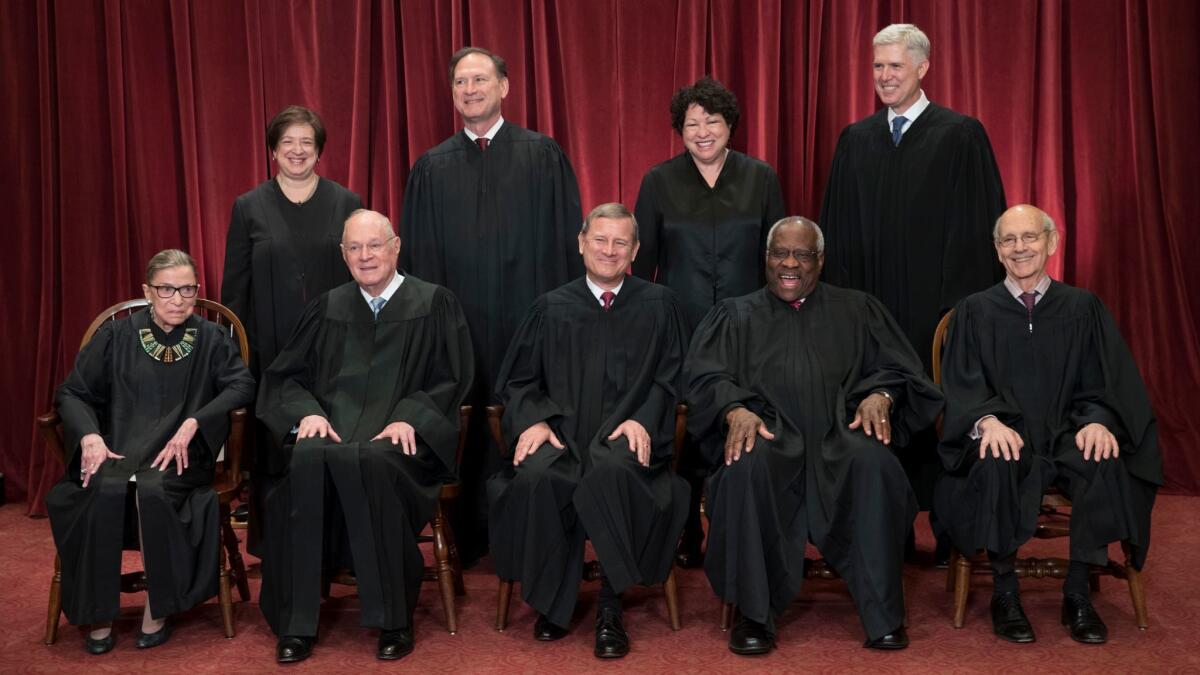Op-Ed: Why the Supreme Court needs 18-year term limits

- Share via
Rumors are swirling that U.S. Supreme Court Justice Anthony Kennedy, the Republican-appointed judge whose swing vote has preserved détente between the court’s left and right for nearly a generation, may announce his retirement in the next year.
The mere idea that Kennedy’s seat could get filled by President Trump and the conservative Republican Senate has sent many on the left into a tailspin of anxiety and despair. In the 28 years Kennedy has served on the court, he has authored opinions or cast tie-breaking votes in major, divisive cases, including decisions that preserved a constitutional right to abortion, recognized social and sexual liberties for gays and lesbians, granted habeas corpus protections to Guantanamo Bay prisoners, confirmed a 2nd Amendment right to own a handgun in the home and applied the 1st Amendment to corporations engaged in political speech.
To many liberals, Kennedy’s replacement with a strict originalist like Justice Neil Gorsuch would feel downright apocalyptic. Indeed, Republican Sen. Orrin Hatch told reporters in April that the battle to replace Kennedy will be “Armageddon.”
Some liberals are so worried about the health of Justice Ruth Bader Ginsburg, who is 84, that they’re sending her kale recipes. Things are clearly out of hand.
Liberals aren’t the only ones who get anxious over Supreme Court appointments, of course. When it seemed Antonin Scalia’s seat would go to Merrick Garland, which would have created a more liberal majority on the court, the Republican-led Senate refused to give Garland any hearings or votes for an unprecedented 293 days – until Obama was no longer president – a maneuver that led to bitter resentment and set a worrisome precedent for future vacancies. Meanwhile, some liberals are so worried about the health of Justice Ruth Bader Ginsburg, who is 84, that they’re sending her kale recipes. Things are clearly out of hand.
This level of speculation, fear and dramatic suspense over when any single public official retires is a sign that the stakes of Supreme Court appointments are simply too high. To lower the stakes – and attending dysfunction – of each court appointment, both parties would do well to consider a scheme put forward by two Northwestern University law professors.
In a 2006 paper for the Harvard Law Review, Steven Calabresi and James Lindgren proposed that Supreme Court justices should serve 18-year terms, with a new judge appointed every two years. Each president would effectively get to nominate two justices for every term in office, and the Senate would agree to promptly consider them on a regular schedule.
The sitting court would be composed of the nine most recent appointees. More senior judges would continue receiving full pay and would sit as judges on lower federal appellate courts or back on the Supreme Court to fill a vacancy or recusal. The plan has the advantage of potentially being achievable by statute, rather than requiring a constitutional amendment.
Of course, a justice might unexpectedly die, retire, resign or be impeached. But for the most part, Supreme Court appointments would become more quotidian, like other executive or judicial nominations. The public, the press and Congress would know what to expect and when to expect it.
With a new justice always around the corner and a built-in limit to the length of any one person’s influence, the Senate could more easily accept an opposing president’s nomination, breaking the go-nowhere tit-for-tat cycle of congressional partisanship that stalled the appointment of Garland.
Such a system would also eliminate the “tyranny of the young,” whereby presidents seek to appoint the youngest possible justices in a calculated effort to further their legacies for the greatest number of decades. New voices and ideas could more easily populate the court, and brilliant, innovative judges wouldn’t be sidestepped for being too old. The frequency of appointments might allow presidents to experiment a little, perhaps by appointing a trial judge or a politician. It might also encourage minority parties and interest groups to limit their cries of impending doom.
The Constitution’s Article III has long been interpreted to grant judges life tenure. But the text actually has some leeway. It states that judges “shall hold their offices during good behaviour” and receive “a compensation, which shall not be diminished” while in office. The rest of the Supreme Court’s structure, and what it means to “hold” the “office” of a Supreme Court justice, is left to Congress.
The benefits of life tenure are clear. By eliminating the ability of political actors to remove judges, the Constitution frees judges to make decisions based on reason and their honest understanding of law, rather than to protect their positions by pleasing a political patron.
But life expectancy today is a full 30 years greater than it was in 1789. In the country’s first 200 years, the average Supreme Court justice served for 15 years; Kennedy is creeping up on 30. Gorsuch, fit and 49 years old, could serve for the next 35 years or more.
That’s a very long time for an unelected official to exercise such vast public authority.
Ben Feuer is chairman of the California Appellate Law Group, an appellate law firm that practices in the U.S. Supreme Court.
Follow the Opinion section on Twitter @latimesopinion or Facebook
MORE FROM OPINION
With Obamacare repeal off the table, will Republicans start trying to actually improve healthcare?
Trump’s biggest success: Proving the inadequacy of federal ethics laws
More to Read
A cure for the common opinion
Get thought-provoking perspectives with our weekly newsletter.
You may occasionally receive promotional content from the Los Angeles Times.










